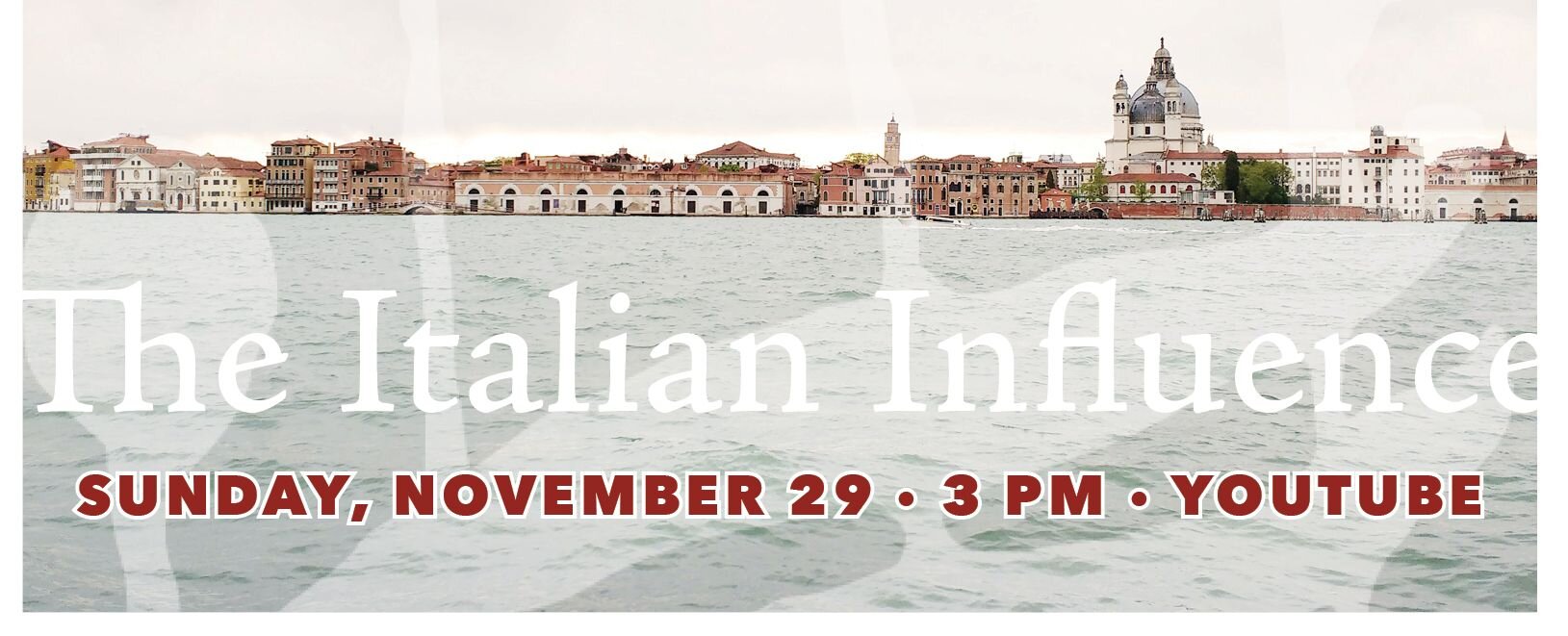The Italian Influence: Program Notes
Jennifer Carpenter
Johann Joachim Quantz
In 1752, the composer/theorist Johann Joachim Quantz (1697-1773) wrote: “The Italian manner of playing is arbitrary, extravagant, artificial, obscure, frequently bold and bizarre, and difficult in execution; it permits many additions of graces, and requires a seemly knowledge of harmony; but among the ignorant it excites more admiration than pleasure.” That’s quite an introduction to the Italian style! Yet, composers around Europe quite readily adopted both the Italian genres and techniques and adapted them to blend with their own national styles.
Tarquinio Merula (1595-1665) is our only Italian composer on this program. He was one of the finest and most progressive Italian composers of his generation, and excelled in both vocal and instrumental music. In the 1630s he wrote several canzonas based on ostinatos, variations on popular tunes, chamber sonatas, sinfonias and a number of dances. His “Ciaccona” from Canzoni overo sonate concertate per chiesa e camera, (1637) is a popular example of this ground bass (ostinato, or repeating bass pattern). The short ostinato pattern in the bass provides the structure for variation and melodic invention by the two treble voices above. Johann Pachelbel (1653-1706) includes a “Ciaccona” (even adopting the Italian spelling) in his Partita V in C Major (Musicalische Ergötzung). His setting is a sweeter, slower version of the popular ostinato and shows the variety possible within settings of the ciaccona.
Quantz continues his description of national styles with describing French baroque music: “The French manner of playing is slavish, yet modest, distinct, neat and true in execution, easy to imitate, neither profound nor obscure, but comprehensible to everyone, and convenient for amateurs; it does not require much knowledge of harmony, since the embellishments are generally prescribed by the composer; but it gives the connoisseurs little to reflect upon…The French [style] depends more upon the composition than the performance, while the Italian depends upon the performance almost as much as the composition, and in some cases almost more…” That’s a lot to digest!
Jean-Marie Leclair
The accomplished French composer Jean-Marie Leclair (1697-1764) quickly gained notoriety for modifying the 18th-century Italian sonata to accommodate French taste. At the time, there was a “battle of French and Italian styles” frequently commented upon by 18th-century writers. The Italians preferred flashes of technical brilliance while the French enjoyed beautiful, détaché melodies and rhythmic flexibility. Leclair provided the goûts réunis (united taste) by imbuing the Italian sonata style with elements drawn from French violin, viol, and harpsichord playing, particularly their style of ornamentation, and combining it with the Italian penchant for flashy fast movements. His Sonata in D Minor, op. 4 no 1 (1731-3) stands as a fine example of Leclair’s goûts réunis with its French sensibilities present particularly in the the first movement, German sensibilities in the fugal second movement, and Italian sensibilities in the final Allegro.
Overall, composer and violinist Jean-Joseph de Mondonville’s (1711-72) style is notably French, with exceptions, including the sonata on this program. In 1734 Mondonville published his Pièces de clavecin en sonates avec accompagnement de violon, op.3. The title indicates that the harpsichord is the principal instrument, but in practice Mondonville achieved a perfect balance between harpsichord and violin, exploiting the possibilities of both instruments. He also finds a balance between the French and Italian styles, particularly in the light-hearted opening “Allegro” and final movement, a giga - adopting the Italian term and sensibilities over the French gigue (both derived from the English jig).
Quantz, a German composer himself wrote: “In German music [of the past]… both style and melodies were rather flat, dry, meagre and paltry…Exciting and quieting the passions were things unknown to them.” I often say that German composers took the best of the French and Italian sensibilities and made them their own. Telemann is no exception.
Georg Philipp Telemann
German composer Georg Philipp Telemann (1681-1767) is one of the most prolific composers in history. His music enjoyed widespread popularity throughout Europe as he wrote pieces in nearly every genre and for wide and sometimes unusual combinations of instruments. Telemann loved to adopt styles from both Eastern and Western Europe and integrate them into his pieces. The Sonates sans Basse à deux Flutes traverses ou violons (French title given by Telemann himself) were widely distributed (published in Hamburg, Amsterdam, Paris, and London during his lifetime) and were likely his most widely played compositions. The cantabile-like slow movement Sonata No. 2 in E Minor (Largo) reveals its Italian sensibilities in its song-like character, while the fugal 2nd movement moves us back to Germany.
The Plas were a Catalan family of virtuoso oboists and composers. The three brothers frequently wrote pieces together making it nearly impossible to accurately attribute a piece to only one of them. Josep Pla (c. 1728-72) most often wrote pieces with his brother Juan Bautista Pla, and this work, the Trio Sonata in d minor, is likely one such example of a joint composition. In general, their works show the strong influence of late Italian baroque and galant styles with a virtuosic spirit coupled with charming melodies.
Quantz inadvertently reveals in his quotes how much musical influence there was between the various national styles. Alone, each style seems to fall rather flat, according to Quantz. But, when composers integrated the national styles together, they were capable of creating something quite alive and poignant. We hope you enjoy the integration of Italian influences throughout the pieces on this program.





